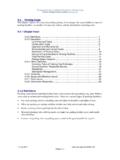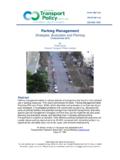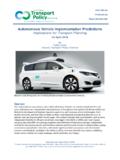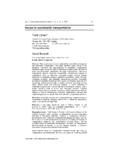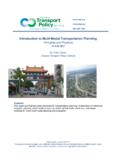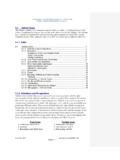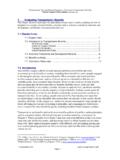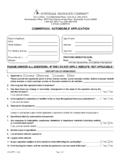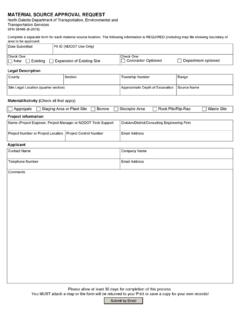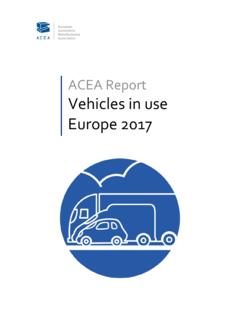Transcription of Automobile Dependency and Economic Development
1 Victoria Transport Policy Institute Website: Email: 1250 Rudlin Street, Victoria, BC, V8V 3R7, CANADA Phone & Fax 250-360-1560 "Efficiency - Equity - Clarity" Institute for Science and Technology Policy Murdoch University Website: E-mail: South Street, Murdoch, WA, 6150, AUSTRALIA Phone +61-8-9360-2913 Fax +61-8-9360-6421 1996-1999 All Rights Reserved Automobile Dependency and Economic Development by Todd Litman Victoria Transport Policy Institute and Felix Laube Institute for Science and Technology Policy Murdoch University, Perth, Australia 6 August, 2002 Abstract Automobile Dependency consists of high levels of per capita Automobile travel, Automobile oriented land use patterns and limited transport alternatives.
2 Automobile Dependency has many impacts on consumers, society and the economy. It increases mobility and convenience to motorists. It increases consumers' transportation costs and resource consumption, requires significant financial and land resources for roads and parking facilities, and it increases traffic congestion, roadway risk and environmental impacts. It reduces the viability of other travel modes and leads to more dispersed land use and mobility intensive Economic patterns that require more vehicle travel for access. This paper examines macroeconomic impacts of Automobile Dependency (impacts on overall Economic Development , productivity, competitiveness and employment). Both Economic theory and empirical evidence indicates that excessive Automobile Dependency reduces Economic Development .
3 Several current market distortions result in Automobile Dependency beyond what is economically optimal. Policies that encourage more efficient transportation and land use patterns can provide Economic benefits. Automobile Dependency and Economic Development 1 Introduction Automobile Dependency is defined as high levels of per capita Automobile travel, Automobile oriented land use patterns and reduced transport The opposite of Automobile Dependency is a balanced transportation system with more mixed travel patterns. Automobile Dependency is a matter of In its extreme, nearly all local trips are made by personal Automobile because alternatives are so inferior. To experience Automobile Dependency , forego driving for a few typical weeks.
4 In a highly Automobile dependent community you will encounter significant problems you may have trouble commuting, running errands, and even crossing busy streets. In a community with balanced transportation you will have fewer problems. Some people suggest that Automobile Dependency always increases as consumers become wealthier,3 but this is not necessarily true. Many wealthier regions have balanced transportation systems while some poorer regions are quite Automobile The differences result from public policies that affect transport choices and land use This paper investigates the macroeconomic effects of Automobile Dependency , that is, its impacts on regional Economic Development (productivity, competitiveness and employment), and conversely the Economic impacts of a more balanced transport system.
5 This is important because transportation is itself a major Economic sector and impacts virtually all other sectors. Public policies influence transportation choices and activities in various ways. Many current policies favor Automobile Dependency , including public expenditures on roads and traffic services, abundant parking requirements, favorable pricing policies, and land use scaled for Automobile travel. These policies reflect an assumption that increased Automobile use provides Economic benefits and reflects consumer demand. However, evidence described in this paper suggests that current market distortions result in excessive Automobile Dependency which reduces Economic Development , that alternative policies which encourage more balanced transportation can increase Economic Development , and in response to such reforms, consumers would choose to drive significantly less and be better off overall as a result.
6 1 Peter Newman and Jeffrey Kenworthy, Sustainability and Cities; Overcoming Automobile Dependency , Island Press ( ), 1998. Also see The Millennium Cities Database for Sustainable Transport, International Association of Public Transport ( ), 2001. Automobile refers to cars, vans, light trucks and SUVs. 2 James Wickham and Maria Lohan, The Social Shaping of European Car Systems, Employment Research Centre, Trinity College (Dublin; ), European Commission, 1999. 3 Kenneth Green, Defending Automobility: A Critical Examination of the Environmental and Social Costs of Auto Use, Reason Foundation (Los Angeles; ), 1995. 4 Jeffrey Kenworthy and Felix Laube, Patterns of Automobile Dependency in Cities, Transportation Research A, Vol.
7 33, No. 7/8, 1999, pp. 691-723. 5 John Pucher and Christian Lef vre, The Urban Transport Crisis in Europe and North America, MacMillan (London), 1996. Automobile Dependency and Economic Development 2 Economic Development Impacts of Automobile Dependency Automobile Dependency has various impacts that affect Economic These are summarized below and some are discussed in detail later in this paper. 1. Increased Mobility And Convenience For Motorists Automobile Dependency directly benefits vehicle users: favorable pricing, investment, facility design, parking and land use practices make driving relatively fast, convenient and affordable. It also allows businesses to use more centralized distribution systems and Just-In-Time production, and to access a wider range of possible employees and customers, which can cause certain types of agglomeration efficiencies, such as large retail centers.
8 These savings and efficiencies can increase Economic Development if they increase the productivity of local industries. These productivity benefits are separate and in addition to consumer benefits from increased mobility. However, not all increased vehicle use by producers represents increased productivity. As discussed later in this paper, Automobile dependent transportation systems and land use patterns require more travel to provide a given level of services. 2. Increased Vehicle And Fuel Expenditures Automobile Dependency increases per capita vehicles and fuel expenditures, often increasing average annual household transportation expenditures by thousands of dollars, and reduces expenditures on other consumer goods.
9 This can have significant Economic impacts, particularly because most vehicles and fuel are imported from other regions. 3. Increased Road And Parking Expenditures Automobile Dependency increases expenditures on roads, traffic services and parking facilities, often averaging hundreds of dollars annually per household. Annual per capita road expenditures average $264 in Automobile dependent cities, $135 in less Automobile dependent European cities, and only $88 in the least Automobile dependent Asian cities, representing savings in both absolute terms and as a portion of Gross Regional 4. Increased Traffic Congestion, Crash Damages And Environmental Impacts Increased Automobile travel tends to increase total traffic congestion delays, crashes and environmental impacts such as air pollution and impervious surface coverages.
10 Although some impacts may be relatively low per kilometer in Automobile dependent areas (for example, traffic congestion is often high in older, multi-modal cities, and per kilometer crash rates are often high in developing countries where Automobile ownership is low), total costs per capita tend to be higher due to high levels of vehicle use. These costs can reduce regional productivity: Traffic congestion reduces the efficiency of businesses and services that involve local travel. Crash damage costs are borne directly through increased insurance fees and lost worker productivity, and indirectly through taxes to cover injuries and disabilities. Environmental damages can cause illnesses and disabilities, and degrades environmental amenities that have market value to real estate and tourism industries.
